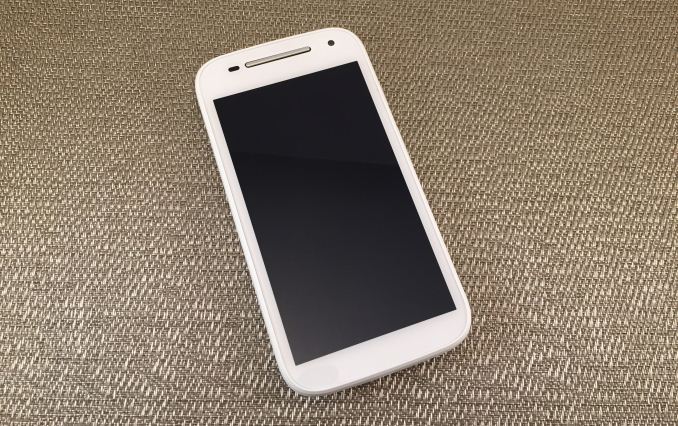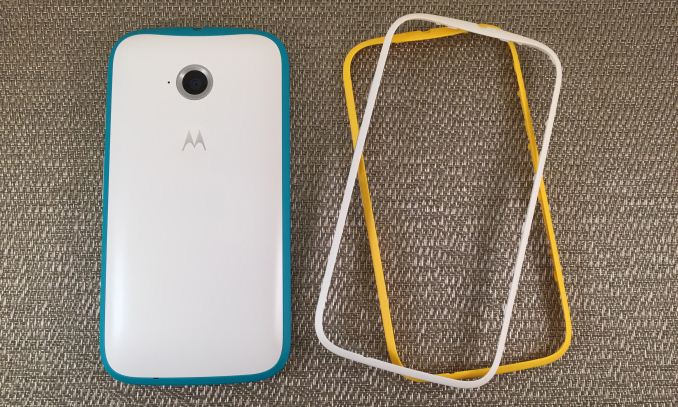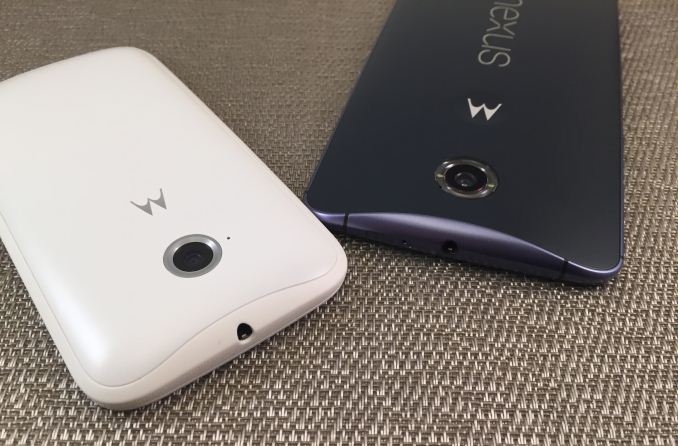The Moto E (2015) Review
by Brandon Chester on April 21, 2015 8:00 AM EST- Posted in
- Smartphones
- Motorola
- Mobile
- Moto E (2015)

During the past couple of years we've seen a dramatic shift in Motorola's strategy for competing in the smartphone market. As one of the earliest producers of Android devices, the company needed to let go of ideas and strategies from years that had since past. Producing exclusive devices for carriers like Verizon was no longer going to work with the iPhone finally freed from exclusivity on AT&T, and Motorola's hardware and software design had begun to show a great deal of age.
That brings us to today, at a point where Motorola has more or less found their new approach to making smartphones. It's a very simple and understandable approach. Consistency across the design of the hardware, consistency across the design of the software, and a yearly line of phones that can easily be divided into budget, mid-range, and flagship categories based on a single letter in their name. This review takes a look at the newest version of Motorola's budget device, the 2015 Moto E. Unfortunately, this year adds a bit of complexity to the simplicity of Motorola's smartphone line. Before getting into that, I've put the general specifications of the new Moto E below, with the original 2014 model as a point of comparison.
| Motorola Moto E (2015) (LTE model XT1527) |
Motorola Moto E (2015) (3G models) |
Motorola Moto E (2014) | |
| SoC | Qualcomm Snapdragon 410 (MSM8916) 4x Cortex A53 @ 1.2GHz Adreno 306 at 400MHz |
Qualcomm Snapdragon 200 (MSM8x10) 4x Cortex A7 @ 1.2GHz Adreno 302 at 400MHz |
Qualcomm Snapdragon 200 (MSM8x10) 2x Cortex A7 @ 1.2GHz Adreno 302 at 400MHz |
| RAM | 1 GB LPDDR3 | 1GB LPDDR2 | |
| NAND | 8GB NAND + microSD | 4GB NAND + microSD | |
| Display | 4.5” 960x540 IPS LCD | 4.3" 960x540 IPS LCD | |
| Network | 2G / 3G / 4G LTE (Qualcomm MDM9x25 UE Category 4 LTE) | 2G / 3G HSPA+ (MDM8x10) | 2G / 3G HSPA+ (MDM8x10) |
| Dimensions | 129.9 x 66.8 x 12.3mm 145g |
124.38 x 64.8 x 12.3mm 142g |
|
| Camera | 5MP (2592 х 1944) Rear Facing w/Auto Focus, F/2.2 aperture VGA (640x480) Front Facing |
5MP (2592 х 1944) Rear Facing w/Fixed Focus | |
| Battery | 2390 mAh (9.08Wh) | 1980 mAh (7.52Wh) | |
| OS | Android 5.0 | Android 4.4.2 | |
| Connectivity | 802.11 b/g/n + BT 4.0, USB2.0, GPS/GNSS | ||
| SIM Size | Micro-SIM | ||
On the cellular side, we have two HSPA models and 1 LTE model of the Moto E. There is an LTE version with UMTS bands targeted at the US market, a 3G-only version for the US market, and a global 3G version. The difference between the US and global 3G bands is the inclusion of the 1700MHz band for T-Mobile support on the US version, and the 900/2100MHz bands on the global version.
Design
Over the past couple of years, Motorola's hardware and software design has undergone some enormous changes. They shifted from producing heavily skinned and modified Android devices to using almost stock Google Android. Their industrial design similarly underwent significant changes, and a new style for their smartphones emerged with the original Moto X in 2013. The flat sides and edges of Motorola's old phones were replaced with continuous curves. This type of design is not only more ergonomic than Motorola's old devices, but also more unique and recognizable. It's very clear from the appearance of a Motorola phone that it is a Motorola phone, even without spotting the depressed logo on the back cover.
The Moto E is no exception to Motorola's industrial design. The back cover has a continuous curve that extends to all corners and meets with the phone's arched sides. The back of the phone has only a center-aligned 5MP camera and Motorola's standard indented logo. Unlike the original Moto E this back cover is no longer removable and customizable with different colors. Since the Moto E is a budget device, it also can't be customized with Motorola's Moto Maker. To add a level of personalization, Motorola has designed the phone so that the band around the edges is removable. Users can purchase a set of red, blue, and yellow bands for $20, and can swap them out with the default white or black bands as they please.
The band being removable creates a potential concern about the usability of the Moto E's buttons, as the part that you press down on is integrated into the bands themselves. During my time with the device I was actually surprised by how tactile the buttons felt and how little they wobbled considering that they were completely separated from the actual button mechanism. They definitely had more of a mushy feeling than the buttons on the Nexus 6, but they were still completely usable and actually better than I expected.
The removable bands also act as a great way to hide many of the ports on the device. Removing the band allows access to the Moto E's MicroSD slot and Micro-SIM port. The SIM slot is spring loaded, but it's so deep that anyone without very long nails will end up having to use a small object to press on the end of the SIM to remove it anyway.
The left side of the device has a tag which is attached internally and has FCC and regulatory information on it, as well as the device's IMEI.
I'm quite happy with the direction Motorola has gone in with regards to design. The basic design of a Motorola phone scales down to $150 devices and all the way up to $700 devices, and on all of them it's visually appealing as well as ergonomic. The material quality definitely takes a step down when you go for those budget devices, with the Moto E sporting a plastic outer band instead of the metal ones on the Moto X and Nexus 6. Despite that, the phone still feels well made and the matte plastic back actually feels just as nice as the one on the Nexus 6. If anything, Motorola might want to worry about their flagship devices not offering enough of an improvement over the very good build quality and materials of their budget offerings.













90 Comments
View All Comments
Hubb1e - Tuesday, April 21, 2015 - link
While the camera performance is pretty meh, I really don't see how you can complain about 802.11n being a downside. AC wireless is nowhere near ubiquitous and N is surely fast enough for low end users. AC is decidedly a high end feature in phones and even computers these days. Most users of this phone probably still have wireless G in their homes or coffee shop hotspots which I would argue is still plenty of speed for a phone with a low end mobile chipset.hans_ober - Tuesday, April 21, 2015 - link
Yeah, it makes more sense to upgrade the cameras to 8MP/2MP than to switch to 802.11ac.Olaf van der Spek - Tuesday, April 21, 2015 - link
The E makes the much more expensive but slower G seem a bit expensive. Is Moto planning a new G?Cryio - Tuesday, April 21, 2015 - link
"It wasn't that long ago that I recommended buyers looking for inexpensive smartphones avoid Android devices in favor of Windows Phone."" With Android Lollipop and new budget devices like the Moto E, my opinion about the quality of low end Android devices has changed."
While all these may be true, the Lumia 640 is a true challenger. There are still reaasons to recommend the 640 over this.
sprockkets - Tuesday, April 21, 2015 - link
Problem is what is the price, and two, it's a 5 inch phone. It was made to compete with the Moto G, not the Moto E.Currently I find WP to be great at first, but after a few days of trying again WP with the Lumia 635, it just flat out tries to annoy me. Today's annoyance is opening up the weather app goes to the store telling me there is a pending update. Then it disappears to the home screen. Before that when I told it to update all apps, it updates 16 out of 26. Why does the next 10 have to have me tell it again to download and install?
After the update it took two tries to open the weather app as it keeps crashing to the home screen.
The camera on it works good for pictures, but is utterly useless at night for video. Why can't they allow exp control for video?
Also learned they won't issue GDR1 or 2 updates for WP8.1 since it will go to WP10. Too bad the latest build is a buggy mess.
BMNify - Tuesday, April 21, 2015 - link
You seem to have a defective Lumia 635, get it replaced, never seen or used such a buggy Lumia, Even the old and humble Lumia 520 performs much better than what you describe.Kakti - Tuesday, April 21, 2015 - link
I bought this phone about two weeks ago from Best Buy - it's $79.99 for the Verizon one with NO contract. Not $120, not $150. $80 bucks. I can buy six of these for the same price as a new galaxy.The size of the phone is perfect, the screen is very nice, and due to the low resolution (compared to flagship phones), the battery actually lasts a really long time. Charging is fast and mine did come with a charger.
I've already recommended this phone to several family members and friends who are sick of 2 year contracts, gigantic phones that don't fit in your pocket, etc. Yes the camera sucks, no it doesn't beat a flagship in bench tests. But I don't run benchmarks, I have maybe 5-6 apps open at once and it has never slowed down or locked up on me.
Honestly if you're looking to save money and not have a laptop jammed into your pocket, take a look at this. The only reason I didn't get the Moto E last year was it didn't have 4G and we don't know how long until the 2015 Moto G comes out. 80 bucks no contract is pretty hard to beat.
BMNify - Tuesday, April 21, 2015 - link
No contract does not mean Unlocked, it is still a Verizon locked phone and that is why you are getting for a lower price. As long as people keep buying locked phones from Carriers they cannot and should not complain about software updates. You become a carrier slave and slaves don't ask.sonicmerlin - Wednesday, April 22, 2015 - link
If it runs on Verizon's LTE then it comes unlocked.RealTheXev - Wednesday, April 29, 2015 - link
I'm pretty sure all Verizon phones on LTE come unlocked. It sucks because some bands that it would normally access will probably require hacking (whenever that might happen), but all of my Verizon LTE phones are unlocked by default.